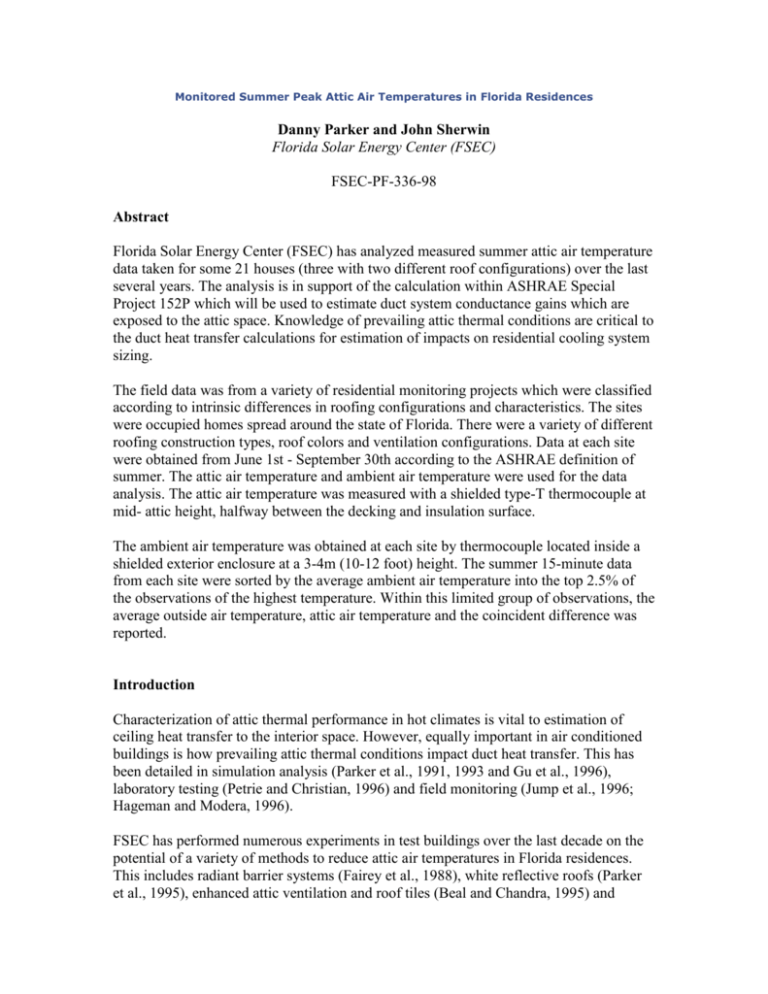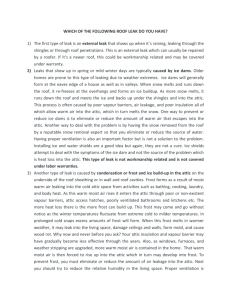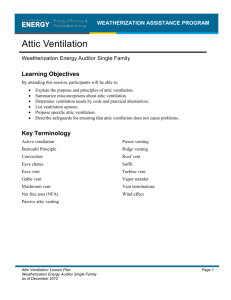Monitored Summer Peak
advertisement

Monitored Summer Peak Attic Air Temperatures in Florida Residences Danny Parker and John Sherwin Florida Solar Energy Center (FSEC) FSEC-PF-336-98 Abstract Florida Solar Energy Center (FSEC) has analyzed measured summer attic air temperature data taken for some 21 houses (three with two different roof configurations) over the last several years. The analysis is in support of the calculation within ASHRAE Special Project 152P which will be used to estimate duct system conductance gains which are exposed to the attic space. Knowledge of prevailing attic thermal conditions are critical to the duct heat transfer calculations for estimation of impacts on residential cooling system sizing. The field data was from a variety of residential monitoring projects which were classified according to intrinsic differences in roofing configurations and characteristics. The sites were occupied homes spread around the state of Florida. There were a variety of different roofing construction types, roof colors and ventilation configurations. Data at each site were obtained from June 1st - September 30th according to the ASHRAE definition of summer. The attic air temperature and ambient air temperature were used for the data analysis. The attic air temperature was measured with a shielded type-T thermocouple at mid- attic height, halfway between the decking and insulation surface. The ambient air temperature was obtained at each site by thermocouple located inside a shielded exterior enclosure at a 3-4m (10-12 foot) height. The summer 15-minute data from each site were sorted by the average ambient air temperature into the top 2.5% of the observations of the highest temperature. Within this limited group of observations, the average outside air temperature, attic air temperature and the coincident difference was reported. Introduction Characterization of attic thermal performance in hot climates is vital to estimation of ceiling heat transfer to the interior space. However, equally important in air conditioned buildings is how prevailing attic thermal conditions impact duct heat transfer. This has been detailed in simulation analysis (Parker et al., 1991, 1993 and Gu et al., 1996), laboratory testing (Petrie and Christian, 1996) and field monitoring (Jump et al., 1996; Hageman and Modera, 1996). FSEC has performed numerous experiments in test buildings over the last decade on the potential of a variety of methods to reduce attic air temperatures in Florida residences. This includes radiant barrier systems (Fairey et al., 1988), white reflective roofs (Parker et al., 1995), enhanced attic ventilation and roof tiles (Beal and Chandra, 1995) and sealed attics with insulation in the roof system (Rudd, et al., 1996). Attic air temperatures vary considerably depending on roofing type, color and ventilation. A good example of the importance of roof reflectance is shown in Figure 1 which plots the measured attic air temperature in a monitored residential site in Florida over the summer months in which the roof was made white on July 6th (Parker and Barkaszi, 1997). Figure 1. Measured 15-minute attic air temperatures in a residence before and after roof was whitened in the summer of 1992. After roof was whitened attic air temperature was often lower than ambient due to heat transfer to the AC duct system. The potential importance of attic ventilation has been investigated by an early series of NBS studies (Reppert ed., 1979). The field data presented are from a variety of projects associated with these parameters and are classified according to intrinsic differences. Each building is classified by a three letter/number code; the sites are spread around the state of Florida.(1) There are a variety of different roofing construction types, colors and ventilation configurations represented. Truss-mounted radiant barriers were present in two attic constructions. Methodology Summer data at each site was obtained from June 1st - September 30th according to the ASHRAE definition of summer. The attic air temperature and ambient air temperature were used for the data analysis. The attic air temperature was taken at mid- attic, halfway between the decking and insulation surface. The attic air temperature was taken with a shielded type-T thermocouple. The ambient air temperature was obtained at each site by a thermocouple located inside a shielded exterior enclosure at a 3-4m (10-12 ft) height adjacent to the building (See Figure 2). Figure 2. Installation of a shielded thermocouple for measurement of site ambient air temperature. Houses in the background are those of a Habitat of Humanity development of which ten houses (see Table 1) have been metered for two years. House has light gray, blue and dark gray shingles. The 15-minute summer data from each site comprised 11,712 observations. These were sorted by the average ambient air temperature into the top 2.5% of the observations (~293) of the highest temperature corresponding to the ASHRAE design condition. Within this limited group of observations, the average outside air temperature, attic air temperature and the coincident difference are reported. Figure 3 shows an example of the measured attic air temperature at one of the sites (HO2) over an entire summer. Figure 3. Measured attic air temperature at site HO2 over the entire summer of 1996. House has a dark gray asphalt shingle roof and is located in Homestead, Florida. Results The tabular results from the above analysis are given below in Tables 1 -5 and in Figure 4 as classified by roof type, color and ventilation. Figure 4. Coincident attic to ambient air temperature difference at ASHRAE summer design condition. It is worth noting that light gray or "white" asphalt shingles have a measured solar absorptance of approximately 75% as opposed to true reflective roofing systems which have absorptances less than 30% (Parker et al., 1993B). Dark gray shingles have a solar absorptance of about 90%. Table 1 Shingle Roofs with Soffit and Ridge Vents Designation Tamb Tattic dT Location H01 H02 H03 H04 H05 o o Year Comments o 91.5 110.8 19.3 Homestead 1996 Lt. Gray shingle 91.1o 111.6o 20.5o Homestead 1996 Lt. Gray 90.6o 108.8o 18.2o Homestead 1996 shingle 91.1o 110.8o 19.7o Homestead 1996 Lt. Gray shingle 91.0o 117.7o 26.7o Homestead 1996 Lt. Gray H06 90.8o 113.1o 22.4o Homestead 1996 shingle H07 91.7o 110.8o 19.1o Homestead 1996 Dark Gray shingle o o o 90.0 114.9 23.1 Homestead 1996 Med. Blue o o o 91.5 115.1 23.7 Homestead 1996 shingle H08 H09 H10 90.9o 114.8o 23.9o Homestead 1996 Lt. Gray shingle Dark Gray shingle Med. Blue shingle Dark Gray shingle Avg 21.7o Table 2 Shingle Roofs with Soffit Venting Only Designation Tamb Tattic dT Location Year Comments ACC 95.0o 127.2o 32.1o Belle 1995 Med. Gray Glade shingle o o o CBS 95.0 127.1 32.1 1995 Belle Lt. Brown o o o Glade CR1 97.1 133.9 36.8 1995 shingle RC3 Avg 91.4o 132.3o 40.8o Hollywood 1995 Black shingles Nobleton Dk. Brown shingle, no ducts 35.5o Table 3 Shingle Roofs with Radiant Barrier and Various Venting Designation Tamb Tattic dT Location Year Comments CR1 WD1 97.2o 117.9o 20.7o Hollywood 1996 Black, Soffit & o o o 95.2 125.0 29.7 Cocoa 1996 Ridge vent Dk. Brown, Soffit vent only Table 4 Tile Roof, Direct Nailed, Standard Venting Designation Tamb Tattic dT Location Year Comments RC5 96.6o 107.2o 10.5o Merritt Island 1993 Gray tile Table 5 White Roofs and Various Venting Designation Tamb Tattic dT Location Year Comments DSP 94.9o 88.6o -6.1o Cocoa Beach 1993 White shingle ridge/soffit vents RC5 94.4o 91.6o -2.9o Merritt Island 1995 White tile (2nd yr.) RC3 91.7o 93.6o 1.9o Nobleton 1994 White (2nd yr.) RC9 93.1o 84.0o -9.0o Cocoa 1995 White gravel (2nd yr.) PT2 91.7o 95.2o 3.4o Palm Bay 1995 White shingle (2nd yr.) RC4 93.4o 87.8o -6.6o Miami 1994 White gravel (2nd yr.) LS1 95.1o 103.4o 8.3o Merritt Island 1995 White shingle (2nd yr.) Average -1.5 Discussion The data set highlights prominent influences on attic thermal performance. The first set of data are from ten 1,100 square foot (100m2) homes of virtually identical construction in Homestead, Florida. Each has both soffit and ridge venting. Only the shingle color varies, an important influence as suggested by the temperature data shown both in tabular form and illustrated in Figure 5. Figure 5. Influence of asphalt shingle color on measured average attic air temperature at two adjacent Homestead, Florida sites (HO2 and HO5) during the summer of 1996. Data from the second group of four homes suggests that soffit venting only can result in substantially higher temperatures than with soffit and ridge venting. This is likely a result of increased ventilation. Note that there are two data sets for location CR1. The first is in its initial condition with a black roof and very little ventilation; the second year is with an attic radiant barrier and soffit and ridge venting. The attic to ambient dT is reduced by 16oF (8.9oC). There are also two years with site RC5, one with gray tile and the other with white tile - both configurations showing better performance than shingle roofs. The data from the homes with white roofs show some variance, but generally indicate much lower coincident attic air temperatures during summer peak conditions. Site RC3 has data from a period with a dark shingle roof and a white roof with dramatic differences. Often with a white roof the attic to ambient temperature difference is negative - seemingly counterintuitive. There are several reasons: Where duct systems are present in attics (all houses, but RC3 above) the heat transfer to the duct system tends to pull the attic air temperature down lower than would occur without this influence. This impact is illustrated in Figure 6 which shows how measured attic air temperatures dropped at site WD1 when the air conditioner was turned on at 1 PM. Figure 6. Influence of duct system heat gain on measured attic air temperature site WD1, August 6, 1997. Short term fluctuations of attic air temperature appear correlated with wind conditions. With a white roof, the solar gain is minimized, so the impact becomes much more apparent. Also, supply leaks from the duct system may further exaggerate this influence as seen by thermography at several sites. Also, heat transfer from the attic to the air conditioned zone tends to reduce attic air temperatures, particularly when low temperatures are maintained (RC9). The attic cools off well below ambient temperatures during evening hours (emitting to night sky) and does not rise to the same level as the ambient air temperature since much of the morning hours are spent evaporating moisture (dew) from the roof surface. The attic air temperature peak may be out of phase with the peak ambient air temperature -- particularly for white tile and gravel roof types which have greater thermal capacitance. Conclusions Although the 21-house data set is not large enough to comprise a statistical sample, it does suggest some important influences on summer attic design temperatures in Florida. Light roof colors, deck-mounted radiant barriers, added attic ventilation and tile roof construction were all shown to reduce peak attic air temperatures. A simple characterization of the collected data would be as follows: Table 6 Comparison of Coincident Attic to Ambient Design Temperature Difference Case Coincident 2.5% Attic Design Temperature Shingle roof, Ambient soffit vent only + 35oF (19.4oC) Shingle roof, Ambient soffit and ridge + 22oF (12.2oC) venting Shingle roof, Ambient Radiant Barrier + 25oF (13.9oC) soffit vent only Tile roof Ambient +10oF (5.6oC) White roof Ambient -1.5oF (0.8oC) Note that this summary does not represent a statistical sample and may only be representative for Florida conditions. Even so, it is likely that the general ranking of identified influences will be observed in measurements elsewhere. A simple calculation illustrates the importance of controlling the peak attic air temperatures measured in this study. As example, consider a residence on a a peak summer day at 95oF served by a three ton cooling system with a sensible capacity of 27,000 Btu/hr and an EER of 9.0 Btu/W. The assumed residence has a 1,800 square foot ceiling with R-30 attic insulation. Supply ducts typically comprise a combined area of ~25% of the gross floor area (see Gu et al. 1997, Appendix G, and Jump and Modera, 1994), but are only insulated to R-4. With the peak attic temperatures for a shingle roof with poor ventilation estimated at 130oF, and 75 maintained inside, a UA dT calculation shows a ceiling heat gain of 3,300 Btu/hr. With R-4 ducts in the attic and a 57 air conditioner supply temperature, the heat gain to the duct system is 8,212 Btu/hr if the cooling system ran the full hour under design conditions-- more than twice the ceiling flux. However, the magnitude of both ceiling and duct heat gain is 43% of the air conditioner's design sensible cooling load. Thus, attic heat to ceiling and attic to duct heat gains are a major portion of the design cooling load for residences. In the example the attic related gains are also responsible for a 1.28 kW increase in peak air conditioning electric demand. As a contrast, with a white roof system, the estimated attic air temperature would be 93.5oF, with a total ceiling and duct heat transfer rate of 5220 Btu-- a reduction of 6,300 Btu/hr and a drop in electrical demand of 700 W if the system was at design capacity with the dark roof. Acknowledgment This work was supported by funding from the Florida Energy Office, whose sponsorship is gratefully acknowledged. Special thanks also, to Iain Walker, at Lawrence Berkeley National Laboratory for helpful comments throughout the analytical process. References D. Beal and S. Chandra, 1995. "The Measured Performance of Tile Roof Systems and Attic Ventilation Strategies in Hot and Humid Climates," Thermal Performance of the Exterior Envelopes of Buildings VI, ASHRAE/DOE/BTECC, p. 753, December, 1995. P. Fairey, M. Swami and D. Beal, 1988. Radiant Barrier Systems Technology: Task 3 Report, FSEC-CR-211-88, prepared for the U.S. Department of Energy, Florida Solar Energy Center, Cocoa, FL. L. Gu, J.E. Cummings, M.V. Swami, P.W. Fairey and S. Awwad, 1996. Comparison of Duct System Computer Models That Could Provide Input to the Thermal Distribution System Standard Method of Test (SPC-152P), FSEC-CR929-96, ASHRAE Project 852-RP, Florida Solar Energy Center, Cocoa, FL. R. Hageman and M.P. Modera, 1996. "Energy Savings and HVAC Capacity Implications of a Low-Emissivity Interior Surface for Roof Sheeting," Proceedings of the ACEEE 1996 Summer Study on Energy Efficiency in Buildings, Vol. 1, p. 117, American Council for an Energy Efficient Economy, Washington D.C. D.A. Jump, I.S. Walker and M.P. Modera, 1996. "Measurements of Efficiency and Duct Retrofit Effectiveness in Residential Forced Air Distribution Systems," Proceedings of the ACEEE 1996 Summer Study on Energy Efficiency in Buildings, Vol. 1, p. 147, American Council for an Energy Efficient Economy, Washington D.C. D.S. Parker, P.W. Fairey and L. Gu, 1991. "A Stratified Air Model for Simulation of Attic Thermal Performance," Insulation Materials: Testing and Applications, ASTM 1116, American Society of Testing and Materials, Philadelphia, PA. D. Parker, P. Fairey and L. Gu, 1993. "Simulation of the Effects of Duct Leakage and Heat Transfer on Residential Space Cooling Energy Use," Energy and Buildings 20, p. 97-113, Elsevier Sequoia, Netherlands. D.S. Parker, J.E.R. McIlvaine, S. Barkaszi and D.J. Beal, 1993B. Laboratory Testing of Reflectance Properties of Roofing Materials, FSEC-CR-670-93, Florida Solar Energy Center, Cocoa, FL. D.S. Parker and S.F. Barkaszi, Jr., 1997. "Roof Solar Reflectance and Cooling Energy Use: Field Research Results from Florida," Energy and Buildings 14, Elsevier Sequoia, Netherlands. M.H. Reppert ed., 1979. Summer Attic and Whole House Ventilation. NBS Special Publication 548, National Bureau of Standards, Washington, DC. T.W. Petrie and J.E. Christian, "Details on Duct Tests ongoing in the Large Scale Climate Simulator," memorandum to Esher Kweller dated September 9, 1996, Oak Ridge National Laboratory, Oak Ridge, TN. A.F. Rudd, J.W. Lstiburck and N.A. Moyer, 1996. "Measured of Attic temperatures in Vented and Sealed Attics in Las Vegas, Nevada," Proceedings of the 14th Annual Excellence in Building Conference, Energy Efficient Building Association, Minneapolis, MN. 1. Homestead is some 50 km south of Miami, Nobleton is in the West Central part of the state; Hollywood is just north of Miami, and Merritt Island, Palm Bay and Cocoa are on the Atlantic coastal zone in central Florida. Belle Glade is in the South Central part of the state Presented at: The 1998 ASHRAE Annual Meeting June 20-24, 1998 Toronto, Canada Privacy Policy | Terms and Conditions | Legal Notices © 2007 Florida Solar Energy Center (FSEC), a research institute of the University of Central Florida. For more information about FSEC, please contact us or learn more








